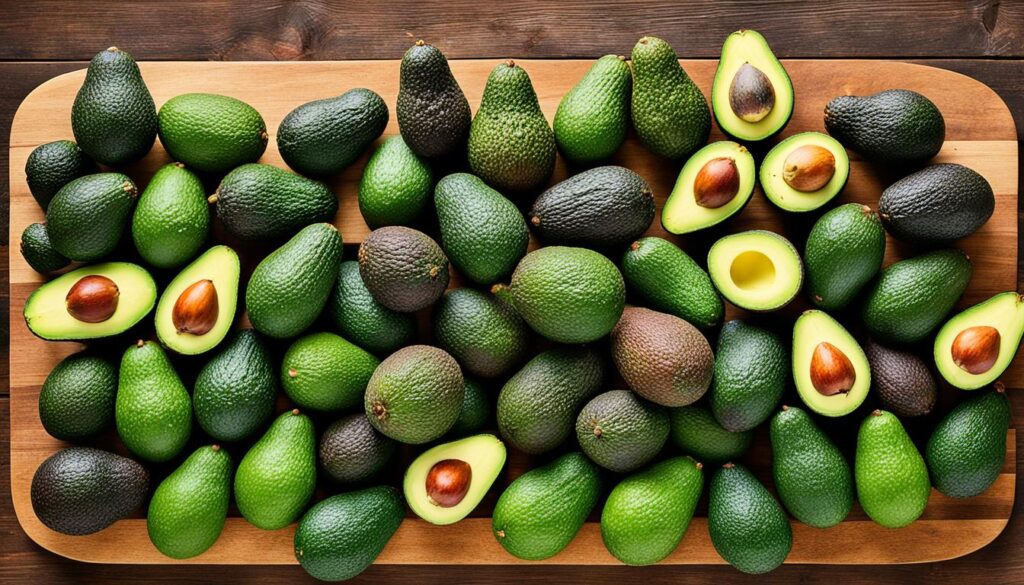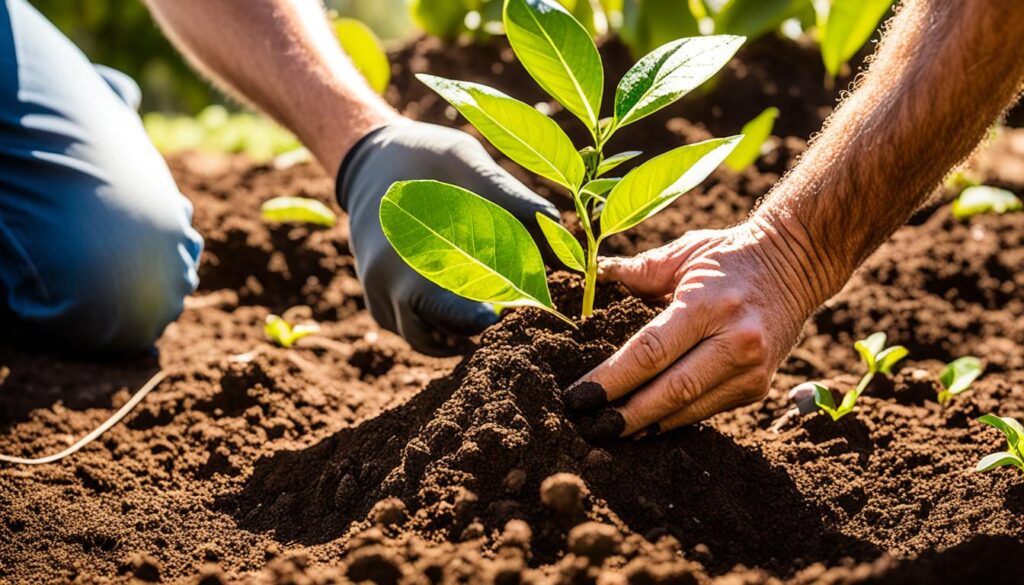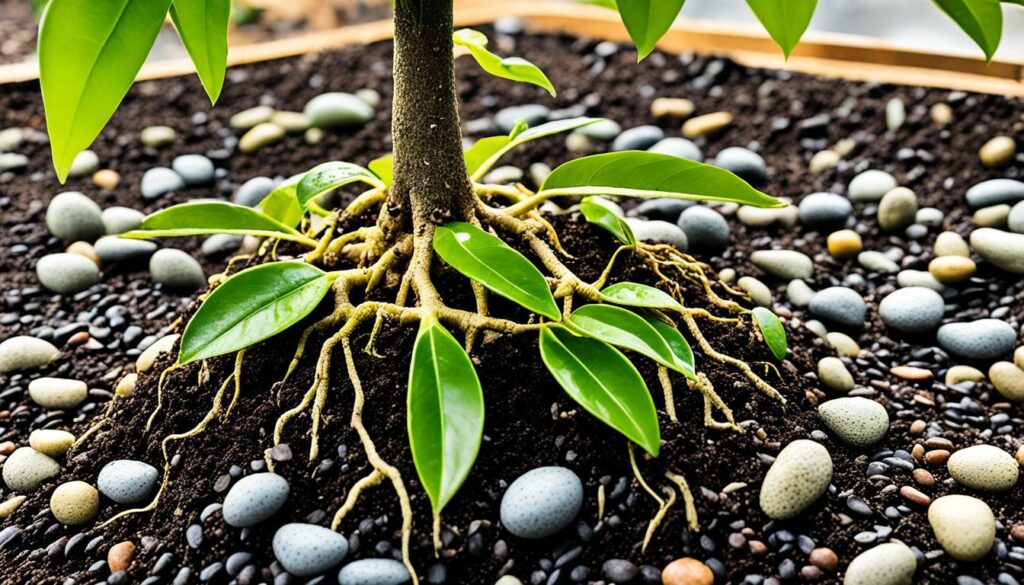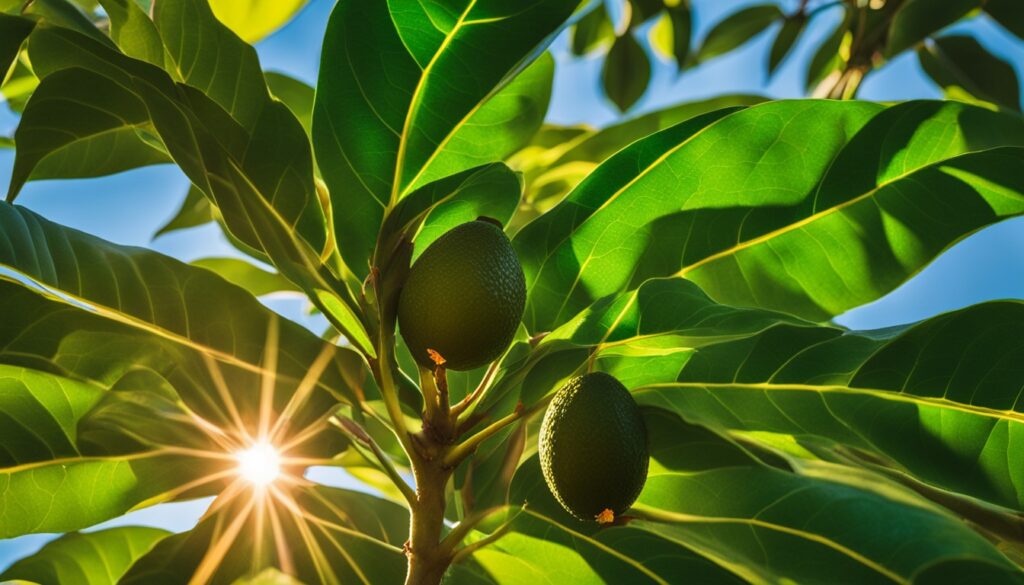Are you curious about growing your own avocado orchard or just want a thriving avocado tree in your yard? This guide is for both experienced avocado growers and new gardeners. It gives you the key tips and techniques to grow avocado trees (Persea americana) well.
Avocado trees are evergreen fruit trees that can grow up to 60 feet tall. They have thick, bright green leaves that add beauty to your garden. But, they only grow well in USDA hardiness zones 9 through 11, which can be a challenge in colder areas.
To keep your avocado trees healthy and productive, focus on soil quality, sunlight, water, food, and trimming. With proper care, your trees can give you 200 to 300 avocados each season.
Are you ready to start growing your own avocado trees? Let’s dive into the essential tips and techniques for a successful avocado orchard or a beautiful tree in your backyard.
Avocado Tree Varieties
There are many avocado tree varieties to pick from. Each has its own special traits. The top three are Hass avocado, Fuerte avocado, and Pinkerton avocado.
Hass Avocado
The Hass avocado is the top choice, making up about 95% of California’s avocados. It was introduced in the 1930s in Southern California. It’s a mix of Mexican and Guatemalan types. Known for its thick, bumpy skin and creamy flesh, Hass avocado trees can grow up to 35 feet tall. But they can also be pruned to be shorter.
Fuerte Avocado
The Fuerte avocado is also a mix of Mexican and Guatemalan types. But it can’t handle the heat as well as the Hass. Fuerte avocados have large, oval fruits with smooth, thin skin. They grow best in Zones 9-11 and are loved for their creamy, tasty flesh.
Pinkerton Avocado
The Pinkerton avocado is from Guatemala. It gives smaller fruits but more of them. These fruits are oblong and have creamy flesh like Hass. Pinkerton trees do well in Zones 9-11 and can handle temperatures down to 30 degrees Fahrenheit.
For the best results, all three avocado varieties need a type A and type B tree for pollination and fruit.

Planting an Avocado Tree
Planting an avocado tree needs careful thought about the right spot, soil, and how to plant it. Follow these steps for the best chance of a thriving tree and lots of fruit.
Choosing the Right Location
Avocado trees need 8 hours of sunlight a day to grow and produce fruit. Pick a spot that gets lots of sunlight. These trees can grow really big, so keep them at least 10 feet away from buildings or other plants.
Soil Requirements
Avocado trees like soil that drains well and has a pH of 5 to 7. If your soil isn’t right, add sand or other materials to make it better. These trees have roots that are easy to damage, so be careful when moving them.
Digging the Planting Hole
The hole for the tree should be as deep as the roots and a bit wider. Loosen the roots before putting the tree in the hole. This helps the roots grow outwards. Fill the hole with the same soil, don’t pack it too hard, and water well to settle the soil.
Proper avocado tree planting is key for its health and fruit production. By picking the right spot, preparing the soil, and planting correctly, you’ll help your avocado tree succeed.

Watering Avocado Trees
Watering your avocado tree right is key to its health and fruit production. These trees need a lot of water but should get it deep and not too often. Wait for the soil to dry out before giving it a good soaking, aiming for about 2 inches of water each week.
In summer, your avocado tree will need more water to stay healthy. Young trees need more water as they grow. But, mature trees usually only need watering once a week. Don’t give them too much water, as this can cause root rot and other problems.
When figuring out how often to water, think about your tree’s size and its location. Trees near the ocean might need 10% less water in summer. Trees inland might need 10% more. Adjust your watering to help your avocado tree grow well.
| Tree Size | Watering Frequency | Summer Water Needs | Winter Water Needs |
|---|---|---|---|
| Young (under 5 feet) | 2-3 times per week | 2-3 inches per week | 1-2 inches per week |
| Mature (5-15 feet) | Once a week | 2 inches per week | 1 inch per week |
| Large (over 15 feet) | Every 7-10 days | 2-3 inches per week | 1 inch every 2 weeks |
These are just basic tips, and you should watch your tree closely. Adjust your watering based on what your tree needs. Proper avocado tree watering and avocado tree irrigation are key for your tree’s health and fruit production.
Fertilizing Avocado Trees
Proper fertilizing is key for avocado trees to grow well and produce lots of fruit. If you’re new or experienced in growing these trees, knowing the best avocado tree fertilizer and when to feed them is important.
Fertilizer Types
Avocado trees need a balanced diet of nutrients, especially nitrogen and zinc. Look for fertilizers made for avocado or citrus trees. They give the right mix of avocado tree nutrients and avocado tree nutrition. Slow-release fertilizers are best because they feed the tree steadily over time.
Fertilizer Schedule
- Start fertilizing in late winter to early spring and keep going through fall, as the product says.
- Young trees need 1/2 to 1 pound of nitrogen a year, spread out over several times.
- Older trees do well with more frequent, smaller amounts of fertilizer during the growing season.
- Give zinc once a year to keep nutrients in balance.
- Don’t over-fertilize, as it can harm the tree’s ability to bloom and produce fruit.
Knowing what avocado tree fertilizer your tree needs and when to feed it helps your trees grow strong. This way, they’ll give you a big harvest every year.

Avocado Tree Sunlight Needs
To thrive, avocado trees need lots of sunlight. They should get at least 8 hours of direct sunlight each day. This helps them grow well and produce fruit.
How much sunlight they get affects their fruit’s taste and texture. Slowly getting used to direct sunlight helps them adjust. This is very important for young or moved plants.
In the Northern Hemisphere, put avocado plants in a south-facing window. In the Southern Hemisphere, use a north-facing window. It’s important to watch how much sunlight they get. Too much can burn the leaves, and too little makes them grow too tall and not flower well.

Helping avocado plants get used to sunlight is important. Start with 50% shade for young trees to prevent burns. Then, slowly give them more sunlight as they grow. Cutting off damaged leaves, giving them something to lean on, and keeping the soil moist helps them flower and produce fruit well.
For indoor avocado plants, put them in bright, indirect sunlight near a south-facing window with a curtain. Or, use grow lights. Place them 12-24 inches above the plant and turn them on for 10 hours a day. This gives them the right amount of light for growing well.
Avocado Trees: Tips for Success
To make your avocado trees thrive, learn about pollination and pruning. These key skills help you get more fruit and keep your trees healthy.
Pollination Tips
For best pollination, grow type A and type B avocado trees together. They bloom at different times, helping each other pollinate. This teamwork is key for lots of fruit.
Pruning Guidelines
Pruning is vital for your avocado trees. Do it in early spring, before February. Don’t prune too much after that, as it can harm the tree. Light pruning can be done any time to keep the tree healthy.
Follow these tips for great avocado trees. Check out the many resources to learn more about caring for your avocado trees.

Growing Avocado Trees from Seed
Growing an avocado tree from a seed is rewarding and saves money. It’s a simple way to enjoy this tasty fruit in your garden. Let’s look at how to sprout the seed and move the seedling.
Sprouting the Seed
First, poke a few small holes in the avocado seed. This lets the seed soak up moisture and start to sprout. Put the seed in a glass of water, making sure the bottom half is under water and the top is out.
Keep the water at 75-80°F. In about a month, the seed should grow roots and leaves.
Transplanting the Seedling
When the seedling has strong roots and leaves, it’s ready for a bigger home. Put it in a potting mix that drains well. Choose a pot that’s at least 10 inches wide, with the seed’s top half out of the soil.
Trim the stem back by half every six to seven inches. This helps the plant grow bushy. When it’s warm enough, move the tree outside to a sunny spot.
Hardiness Zones for Avocado Trees
Avocado trees love warm and humid places. They do best in temperatures between 50°F and 85°F. They can grow outside in USDA hardiness zones 9 through 11, where it doesn’t get colder than 20°F.
In colder areas, avocado trees can’t handle frost well. They might not grow or produce fruit. Some types like the West Indian and Guatemalan can handle cooler temperatures. But the Mexican avocado is the most cold-hardy, surviving down to 19°F or 20°F.
But even the Mexican avocado can be hurt by freezing for a long time. This makes avocado trees hard for gardeners in cooler places.
For those outside the best zones, you can grow avocado trees indoors in pots. But, they might not grow as big or produce as much fruit as they would outside.



